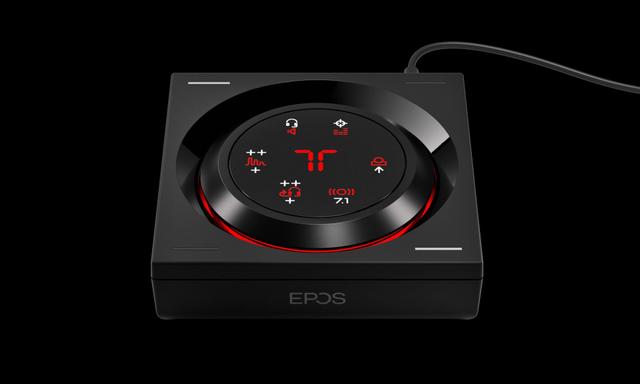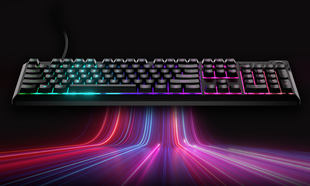Almost every motherboard comes with a built-in soundcard, so why spend €200 on an external one? Well, the GSX 1000 does a lot more than your standard onboard soundcard.
First of all the design, unsurprisingly for EPOS, is great. This is a very nice-looking piece of kit. The matte black finish and red lights give off a “1980s fighter jet” kind of vibe, especially with the volume in a retro seven-segment display. There’s a red bar in each corner which you can programme to save different settings, and there are a lot of customizable settings.
The one moving part, the large aluminium volume wheel, is one of the most prominent features of the GSX 1000. It has a nice smooth movement with a good amount of resistance but doesn’t have any clicks for volume levels. The screen is a touchscreen so thankfully to avoid miss-presses and guide your finger to the wheel in the dark, there’s a V-shaped trough all around it and a red ring underneath.
The touchscreen itself comes to life by either adjusting the volume or simply waving your hand over the display. The buttons on the touchscreen are all spaced far enough away from each other that there’s little danger of an accidental press there too, and this also allows a visual display of which setting you have active.
Interestingly the soundcard allows for two audio outputs, labelled as headphones and speakers, but you could use them for pretty much anything. Changing between these is easy as there is a dedicated button on the display. The equaliser button has settings for general, gaming, film, and music. You can also change the sound environment settings from standard to specifically for confined spaces or open world depending on what kind of game you’re playing. Another two buttons each control the mic feedback, which can be set to off, on, or high, and another for changing from two-channel stereo to 7.1 surround sound. The last button changes the sound stage, so the audio feels like it’s more in front, balanced, or behind you.
Individually these settings may seem a bit underwhelming as you read them, but combined and in action they allow for an incredible level of customization. You can fine-tune the sound of your gaming, music, and movie-watching experience, and saving each one to a preset button is the quality of life (and sound) improvement you didn’t know you needed.
And if any of the above sounds complicated, don’t worry. The GSX 1000 gen.2 is literally plug and play, no need for lengthy installations routing meters of cables around your desk. Just plug in both ends of the USB cable, and plug your headset in the back – it’s as simple as that. Then turn on your favourite game, cycle through each setting on the screen to find your favourite, et voilà.
So, if you want to experience the next level of sound in gaming, movies and music, this is an easy recommendation, but if you have some other basic upgrades you need to do first like CPU/GPU/RAM or motherboard, go for those first because this will eat up a lot of your budget.








































































